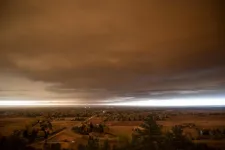(Press-News.org) Smoke from local wildfires can affect the health of Colorado residents, in addition to smoke from fires in forests as far away as California and the Pacific Northwest.
Researchers at Colorado State University, curious about the health effects from smoke from large wildfires across the Western United States, analyzed six years of hospitalization data and death records for the cities along the Front Range, which reaches deep into central Colorado from southern Wyoming.
They found that wildfire smoke was associated with increased hospitalizations for asthma, chronic obstructive pulmonary disease and some cardiovascular health outcomes. They also discovered that wildfire smoke was associated with deaths from asthma and cardiovascular disease, but that there was a difference in the effects of smoke from local fires and that from distant ones.
Long-range smoke was associated with expected increases in hospitalizations and increased risk of death from cardiovascular outcomes.
But when the research team separated out health effects of smoke from local wildfires in early summer 2012 from long-range smoke from late summer 2012 and summer 2015, they found that local wildfires were associated with meaningful decreases in hospitalizations, especially for asthma.
The study, "Differential Cardiopulmonary Health Impacts of Local and Long?Range Transport of Wildfire Smoke," was recently published in GeoHealth, a journal from the American Geophysical Union.
Residents protect themselves from local fires
Sheryl Magzamen, lead author of the study and an associate professor in the Department of Environmental and Radiological Health Sciences at CSU, said the team believes that evacuation efforts and related media coverage of local wildfires may have helped protect residents from adverse health effects of smoke exposure as well as direct impacts of the fires.
"There's a lack of communication about smoke from distant wildfires," said Magzamen. "Generally when there are local fires, there are advisories in the news that are associated with evacuations and local fire conditions. Due to the presence of the fire, people take measures to protect themselves. This could be why we see this lower risk of health effects from smoke associated with local fires."
Researchers described the long-range wildfire smoke as resembling fog, which is what Magzamen said she noticed in Fort Collins in August 2015. At the time, she was collaborating on a project with Jeff Pierce, associate professor in the Department of Atmospheric Science.
"I thought it was weird to see fog on that day," she explained. "Jeff said, 'That's actually smoke.' We all took a step back."
Smoke changes with age
Pierce, a co-author on this study, said researchers don't really know how harmful smoke is as it gets older, or becomes long-range smoke.
"In Fort Collins, about half the time we had smoke in late August or September 2020, this was smoke from the Cameron Peak Fire," he explained. "This smoke was only a couple hours old when it got here. At other times, we were getting smoke from California, and the smoke from the Cameron Peak Fire was either going over our heads or further south."
The Cameron Peak Fire was reported on Aug. 13, 2020, and burned into October, consuming 208,913 acres on the Arapaho and Roosevelt National Forests in Larimer and Jackson Counties and Rocky Mountain National Park. It was the first wildfire in Colorado history to burn more than 200,000 acres.
The average person would not notice a difference in wildfire smoke, Pierce said.
"If the smoke is even two days old, things happen chemically, which changes the smoke a lot," he explained. "If it didn't smell like wood burning, it was long-range smoke from California."
Magzamen said that the team is working to better understand these chemical changes.
"As the small particles found in wildfire smoke age, they can cause more oxidative stress and more respiratory health effects," she said. "But wildfire smoke itself is a mixture of particles and gases. Teasing apart the effects of all the components of smoke and what happens to the mixture across space and time - and how those changes impact health - is an enormous scientific challenge."
Better air quality monitoring
Magzamen said the gap in understanding the source of wildfire smoke is because it historically has been measured by land-based sensors, which are primarily located in large urban areas and sparsely located in other regions, even along the Front Range.
"Even over the last five years, our air quality monitoring networks have been enhanced with new technologies and better measurements of real-time smoke effects," she said.
CSU researchers are now collaborating with local government officials on messaging related to the different types of wildfire smoke, with a specific aim to reach the most vulnerable populations. This includes caretakers of young children, people experiencing homelessness and others who can't shelter safely in place during wildfire season.
"We want people to be smoke-aware," she said. "On the Front Range, we have wildfire smoke every summer. We may not get Cameron Peak-size type of fires every year, but we are downwind for pretty much the entire Western United States," she said. "It's critical that we keep people healthy and safe."
INFORMATION:
Additional co-authors on this study include Ryan Gan and Jingyang Liu (CSU Department of Environmental and Radiological Health Sciences); Katelyn O'Dell, Research Scientist Bonne Ford and Associate Professor Emily Fischer (CSU Department of Atmospheric Science); Kevin Berg and Kurt Bol (Colorado Department of Public Health and Environment) and Assistant Professor Ander Wilson (CSU Department of Statistics).
Researchers at Skoltech and their colleagues proposed a photonic device from two optical resonators with liquid crystals inside them to study optical properties of this system that can be useful for future generations of optoelectronic and spinoptronic devices. The paper was published in the journal Physical Review B.
The simplest kind of optical resonator consists of two mirrors directly opposite each other, "squeezing" light between them. When you stand inside a mirror resonator, you see infinite copies of yourself in the mirrors; when a liquid crystal - the kind in your computer and smartphone screen - is placed into a much smaller and a bit more complex resonator, ...
Cancer patients often experience fragmented care, particularly as they undergo cancer treatments. Although family physicians seek to provide continuous and comprehensive care, they often lose touch with their cancer patients during the treatment phase. Researchers conducted a randomized intervention that aimed to improve continuity of care and interprofessional collaboration as perceived by lung cancer patients and their family physicians.
The components of the intervention included the bidirectional exchange of patient information and care summaries between oncology teams and family physicians. Oncology ...
While many celebrate apple blossoms as classic signs of spring, they are also welcoming entry gates for pathogens. Full of nutrients to lure pollinators and promote pollen germination, flowers also attract bacteria like Erwinia amylavora, a pathogen that causes a damaging disease called fire blight. However, recent work by scientists at the Connecticut Agricultural Experiment Station suggests that these flowery infection sites might also be perfect targets for applying microbial fire blight biocontrol measures.
In a paper recently published in Phytobiomes Journal, researchers Zhouqi ...
LA JOLLA, CA--Translational research led by scientists at La Jolla Institute for Immunology (LJI) has resulted in a promising combination therapeutic candidate for adults with recent-onset type 1 diabetes.
The combination therapy was recently tested in a randomised, double-blind, placebo-
controlled, phase 2 trial run and funded by pharmaceutical company Novo Nordisk. The results, published recently in The Lancet Diabetes and Endocrinology, point to a potential way to treat the autoimmune disease without leaving the body vulnerable to infectious disease.
The therapeutic candidate combines anti-IL-21 antibody with the diabetes drug liraglutide. This ...
COLUMBIA, Mo. - In the midst of a pandemic that has claimed more than 2 million lives worldwide and disrupted nearly every facet of society since it appeared more than a year ago, understanding the factors that create and facilitate disease outbreaks is more important than ever. Now, researchers at the University of Missouri have determined that cognitive biases -- patterns of errors in thinking that affect judgments and behaviors, often unconsciously -- can help create and worsen foodborne disease outbreaks.
"Unethical behavior isn't always intentional; conflicts of interest and other unconscious motivations can lead people to behave ...
WHAT:
Approximately two years after establishing a human cerebral organoid system to study Creutzfeldt-Jakob disease (CJD), National Institutes of Health researchers have further developed the model to screen drugs for potential CJD treatment. The scientists, from NIH's National Institute of Allergy and Infectious Diseases (NIAID), describe their work in Scientific Reports.
Human cerebral organoids are small balls of human brain cells ranging in size from a poppy seed to a pea; scientists use human skin cells to create them. CJD, a fatal neurodegenerative brain disease of humans caused by infectious prion proteins, affects about 1 in 1 million people each year. It can arise spontaneously, result from ...
Philadelphia, March 9, 2021 - Schizophrenia is a neurodevelopmental disorder that disrupts brain activity producing hallucinations, delusions, and other cognitive disturbances. Researchers have long searched for genetic influences in the disease, but genetic mutations have been identified in only a small fraction--fewer than a quarter--of sequenced patients. A new study now shows that "somatic" gene mutations in brain cells could account for some of the disease neuropathology.
The study, led by senior author Jeong Ho Lee, MD, PhD, at Korea Advanced Institute of Science and Technology and the team of Stanley Medical Research Institute, appears in Biological ...
According to the current BfR-Corona-Monitor of the German Federal Institute for Risk Assessment (BfR), 43 percent of the respondents have already had themselves tested for the virus. The survey, which has been conducted regularly for almost a year now, documents how the population is dealing with the situation, what they are doing to protect themselves and how they are informing themselves about the current events. "For 50 weeks now, our survey has provided insights into the current situation and its development," says BfR-President Professor Dr. Dr. Andreas Hensel. "Over time, we see that the vast majority of the population is implementing the key protective measures."
BfR-Corona-Monitor as to 2-3 March 2021:
https://www.bfr.bund.de/cm/349/210302-bfr-corona-monitor-en.pdf
Regarding ...
PLYMOUTH MEETING, PA [March 9, 2021] -- New research in the March 2021 issue of JNCCN--Journal of the National Comprehensive Cancer Network from Mass General Hospital Cancer Center, Harvard Medical School, and Dana-Farber Cancer Institute finds muscle mass (quantity) correlated with survival, while muscle radiodensity (quality) was associated with symptom burden, healthcare use, and survival in patients with advanced cancer undergoing an unplanned hospitalization. The researchers also found nearly two-thirds of the patients in that population had significant muscle loss ...
BUFFALO, N.Y. -- New research from the University at Buffalo suggests that breast cancer patients who drink sugar-sweetened beverages regularly are at increased risk for death from any cause and breast cancer in particular.
Compared to women who never or rarely drank non-diet soda, those who reported drinking non-diet soda five times or more per week had a 62% higher likelihood of dying from any causes, and were 85% more likely to die from breast cancer specifically. The findings were published online ahead of print March 2 in Cancer Epidemiology, Biomarkers & Prevention, a journal of the American Association for Cancer Research.
Research on soda and breast ...







